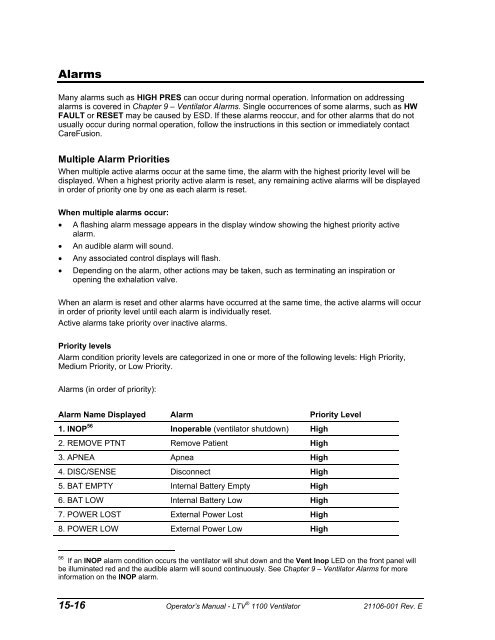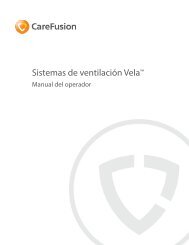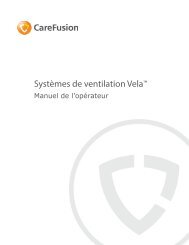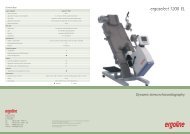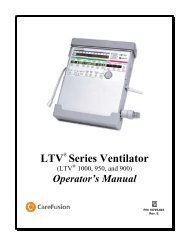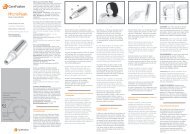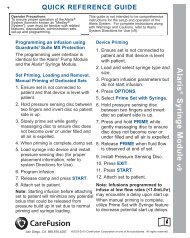LTV 1100 Operator Manual - CareFusion
LTV 1100 Operator Manual - CareFusion
LTV 1100 Operator Manual - CareFusion
You also want an ePaper? Increase the reach of your titles
YUMPU automatically turns print PDFs into web optimized ePapers that Google loves.
Alarms<br />
Many alarms such as HIGH PRES can occur during normal operation. Information on addressing<br />
alarms is covered in Chapter 9 – Ventilator Alarms. Single occurrences of some alarms, such as HW<br />
FAULT or RESET may be caused by ESD. If these alarms reoccur, and for other alarms that do not<br />
usually occur during normal operation, follow the instructions in this section or immediately contact<br />
<strong>CareFusion</strong>.<br />
Multiple Alarm Priorities<br />
When multiple active alarms occur at the same time, the alarm with the highest priority level will be<br />
displayed. When a highest priority active alarm is reset, any remaining active alarms will be displayed<br />
in order of priority one by one as each alarm is reset.<br />
When multiple alarms occur:<br />
A flashing alarm message appears in the display window showing the highest priority active<br />
alarm.<br />
An audible alarm will sound.<br />
Any associated control displays will flash.<br />
Depending on the alarm, other actions may be taken, such as terminating an inspiration or<br />
opening the exhalation valve.<br />
When an alarm is reset and other alarms have occurred at the same time, the active alarms will occur<br />
in order of priority level until each alarm is individually reset.<br />
Active alarms take priority over inactive alarms.<br />
Priority levels<br />
Alarm condition priority levels are categorized in one or more of the following levels: High Priority,<br />
Medium Priority, or Low Priority.<br />
Alarms (in order of priority):<br />
Alarm Name Displayed Alarm Priority Level<br />
1. INOP 56 Inoperable (ventilator shutdown) High<br />
2. REMOVE PTNT Remove Patient High<br />
3. APNEA Apnea High<br />
4. DISC/SENSE Disconnect High<br />
5. BAT EMPTY Internal Battery Empty High<br />
6. BAT LOW Internal Battery Low High<br />
7. POWER LOST External Power Lost High<br />
8. POWER LOW External Power Low High<br />
56 If an INOP alarm condition occurs the ventilator will shut down and the Vent Inop LED on the front panel will<br />
be illuminated red and the audible alarm will sound continuously. See Chapter 9 – Ventilator Alarms for more<br />
information on the INOP alarm.<br />
15-16 <strong>Operator</strong>’s <strong>Manual</strong> - <strong>LTV</strong> ® <strong>1100</strong> Ventilator 21106-001 Rev. E


